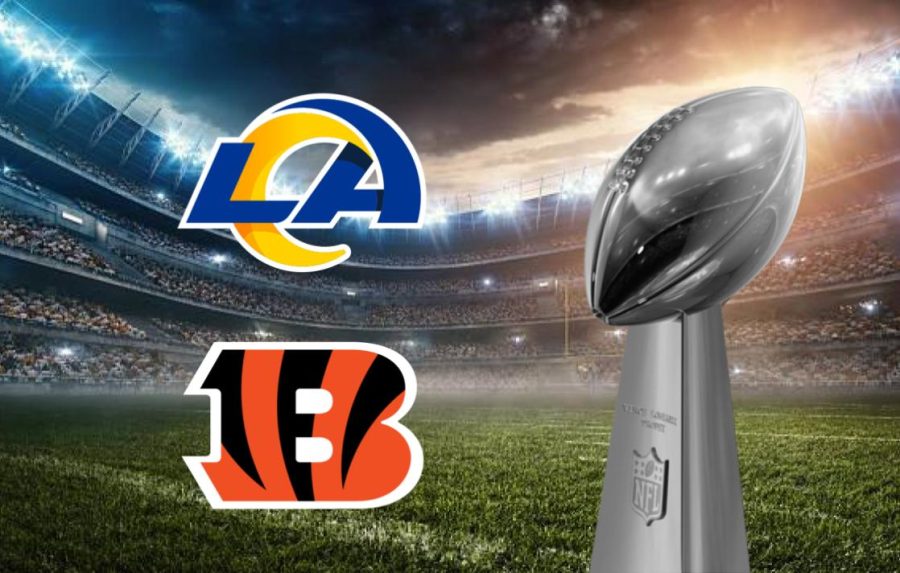Superbowl LVI: After 55 years of America’s biggest game, how does this season stack up?
Every year, a new cast of teams, performers, and commercials hits the Super Bowl stage, but not all Super Bowls are created equal.
This year’s Super Bowl pitted the Los Angeles Rams against the Cincinnati Bengals.
Football is an American staple. Ever since the NFL’s founding in 1920, at which it was originally called the American Professional Football Association (APFA), Americans have been transfixed by the brutal tackles, hail marys, quarterback sneaks, and impressive athletic feats associated with the sport.
Soaring with time, the NFL’s popularity and widespread viewership has culminated in the creation of the Super Bowl. The Super Bowl, too, has become a key piece of American entertainment.
A whopping 96.4 million people viewed last year’s championship game. Shockingly enough, even with approximately 30% of the American population watching the 2021 Super Bowl, viewership wasn’t even at its peak; in 2015, 114 million viewers tuned in, a number averaging 1 in every 3 Americans.
A History of Competition
The Super Bowl itself wasn’t brought into being until the NFL had been in existence for more than 40 years. Brought about by a football feud in which the American Football League was established by a group of businessmen looking to make an extra buck, thus challenging the NFL for fans, players, and ultimately, money, a rivalry between the AFL and NFL played out for years before they merged the leagues and launched the Super Bowl.
The Road to the Superbowl
This year especially, the playoffs were heated as close games and intense rivalries culminated in games boasting about 33 million viewers nationwide.
On January 22, all eyes were on Joe Burrow as the Bengals and Titans battled it out. After some early scoring from the Bengals in the first quarter, the Titans fought back, and by the time the third quarter came to a close, the teams were tied at 16-16. The Bengals then scored a game-winning field goal in the fourth quarter, winning by a mere 3 points.
By the evening of January 22, focus had shifted to the Green Bay Packers and San Francisco 49ers. Scoring early, the Packers led for most of the game. In a dramatic fourth quarter, though, the 49ers scored 10 points, upsetting the Packers 13-10.
In a continuation of the eventful playoff season, the Tampa Bay Buccaneers and Los Angeles Rams were closely matched in their January 23 face off. Starting the game off strong, the Rams scored 20 points in the first half; the Bucs trailed with a pitiful three points. While the Buccaneers came out of halftime strong, scoring 24 points in the second half, it wasn’t enough to defeat the rams, who after a touchdown and field goal, bested the Buccaneers 30-27.
Following the Bucs-Rams game on January 23, the Buffalo Bills and Kansas City Chiefs met each other in an action-packed evening game. Right out of the gates, the two were neck-and-neck, each scoring two touchdowns in the first half and entering halftime tied. After the half, they continued to battle it out, eventually plunging the gripping game into overtime, where the Chiefs scored first, advancing to the American Conference championship game with a score of 42 to 36.
Upon making it to the National Conference championship, the 49ers and Rams duked it out in yet another eventful battle. For the first three quarters, the 49ers led, scoring 17 points to the Rams’s 7. However, after a 13-point fourth quarter, the Rams ended the game 20-17, securing another 3-point win and a place in the Super Bowl.
American Conference champions, the Cincinnati Bengals went down to the wire as well. Playing the Kansas City Chiefs, they trailed leading into the half, but came out swinging and scored 11 points in the third quarter to tie up the game. After two fourth quarter field goals, one from the Chiefs and one from the Bengals, the game went into overtime. Scoring a game-winning field goal, the Bengals, too, had cemented themselves as contenders in Super Bowl LVI.
The Big Game
Cincinnati kicked off Super Bowl 56 after winning a coin toss from Billie Jean King and deferring until the second half. The game to come was chock full of back-and-forth as the two teams played their hearts out in a Super Bowl to remember.
A pass from Rams quarterback Matthew Stafford to wide receiver Odell Beckham Jr. marked the first score of the game as the Rams marched down the field, putting 6 points on the board, which were quickly followed up by an extra point.
Entering the red zone after a 46-yard pass from quarterback Joe Burrow to wide receiver Ja’Marr Chase, the Bengals responded quickly. However, they were unable to enter the endzone, settling instead for a field goal from rookie kicker Evan McPherson.
While the Rams started the second quarter strong with a scoring drive that culminated in a touchdown pass from Stafford to Cooper Kupp, they were unable to get their extra point after a dropped punt, reaching a score of 13-3 nonetheless.
The Bengals responded in kind, scoring on a touchdown pass from running back Joe Mixon to wide receiver Tee Higgins. After a successful extra point from the Bengals, the score going into half was 13-10, with the Rams in the lead.
On the first drive of the second half, the Bengals preserved their momentum as Higgins ran for a 75-yard touchdown after catching a long pass from Burrow. Their luck continued as Stafford went on to throw an interception on the next possession, turning the ball over and opening up an opportunity for the Bengals, who went on to score a field goal later in the third quarter.
The Rams, too, scored a field goal in the third quarter, but were trailing the Bengals as they headed into the fourth quarter 16-20.
After the fourth quarter began, the game remained quiet, and it wasn’t until there were two minutes left in the fourth quarter that the Rams resumed their lead with a touchdown from Stafford to Kupp.
The pressure was on for the Bengals as they took possession of the ball, but after Burrow was sacked by Rams defensive tackle, Aaron Donald, the game was decided and the Los Angeles Rams became the Super Bowl LVI champions after a tense game of trading touchdowns.
In a post-game interview, Rams head coach Sean McVay touched on the game’s small score margin, saying that “they (the Bengals) played the same way that we (the Rams) did, we just found a way to make a couple more plays than they did.”
Halftime Show; Big-time Artists
Kicking off with a visionary theme, the Super Bowl LVI Halftime Show set a sublime standard for performances to come; it—literally—created a map to success in regards to group acts. Dr. Dre, Snoop Dogg, Mary J. Blige, Kendrick Lamar, and Eminem scored in a plethora of ways while producing fun, positive energy for crowds in person and at home. Lydia Pedersen agreed, saying “My parents and I thought the halftime show was spectacular. It gave my mom and dad the nostalgia of being teens in the 90s while still living up to modern expectations of a show that scale.”
Most prominently, the show gave tribute to rap legend Tupac Shakur and former NFL player Colin Kaepernick during songs “California Love” and “Still D.R.E.”, respectively. These subtle nods showed appreciation without consuming the break, boosting it but refraining from being overbearing.
The acts also featured a mob of dancers ready to lose themselves in the music, synchronizing into militaristically precise formations that stole the show with swagger. As best showcased by Kendrick Lamar and surprise guest 50 Cent, clever props elevated the deft performers to another level. Additionally, inactive workers doubled as actors, bringing the house-party-like backdrop to life.
While everyone in the background glimmered, the show had some stars that shone the brightest. Mary J. Blige’s and Dr. Dre’s songs glinted like diamonds in the comparative rough, standing out amongst multiple memorable acts. Blige’s singing offered a pleasant intermission between artists as Dre’s nearly universal presence in the production maintained the flow and allowed for smooth transitions from piece to piece.
Any criticisms aimed at this year’s Halftime Show are due to the time constraints imposed on performers. With only about 15 minutes allotted for the entire performance, each artist hardly had any time to make an impression. Still, each act managed to remain distinct from the others, functioning as a testament to the versatility of these performers.
In total, the 56th Halftime Show was a revolutionary introduction of rap to the NFL in addition to a resounding success in practically every aspect. Its primary downfall was the time given to each performer. If this was a game, each starring player would stay winning.
A New Breed of Advertisements
Despite its eminence as the nation’s most popular football game, the Super Bowl has quickly become renowned for its entertainment value in the form of commercials. Usually avoided for their interruption of the desired program, Super Bowl commercials are something of a cultural phenomenon as they draw their own crowd of viewers.
CFHS junior and Super Bowl viewer Jessica Baszuro expressed her appreciation for advertisements, expressing that “The commercials for the Super Bowl is where the real fun is at. I honestly couldn’t are less about the game, I just like to the the wacky stuff companies can come up with for their super expensive thirty seconds of air time.”
Super Bowl commercials held a whopping 7 million dollar price tag for the 2022 game. However, this year’s advertisement fare simply didn’t live up to the outlandish standards set by previous commercial repertoires.
Star-studded commercials are a Super Bowl staple, and this year was no different. Ty Burrell and his poor money management strategies made a comedic appearance in a Greenlight commercial, Paul Rudd and Seth Rogen reminisced on their “Golden Memories” with Lays chips, and Jim Carey revived his role as the Cable Guy in a commercial for Verizon home internet. All of these celebrities were featured in some of the night’s more interesting commercials, but companies had far more to offer.
In an offbeat and slightly disturbing portrayal of their iconic cylindrical cans, Pringles showcased an unfortunate man whose hand becomes stuck in a Pringles can, and remains so for every major life event. Uber Eats produced another notable commercial as they showcased a variety of celebs eating a multitude of (non-edible) objects, all while running a disclaimer across the bottom of the screen that discourages the consumption of candles and such.
While a handful of the commercials were interesting, in a program over two hours with million-dollar commercial slots, this year’s advertisement game left something to be desired—even if Avengers fans were finally able to see goats dressed up as their favorite characters thanks to an intriguing ad courtesy of Disney+.

Hi Everyone! My name is Lauren Ritz and I'm a senior editor-in-chief for the Lantern. When I'm not editing articles and cooking up graphics, I enjoy playing...

This is Tristin and he doesn't have the brain capacity to write a clever bio right now. Ah


